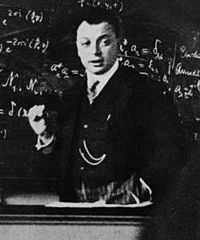Pauli exclusion principle facts for kids
The Pauli exclusion principle is a super important rule in physics. It says that two of the same kind of tiny particles, called fermions, cannot be in the exact same place at the exact same time with the exact same energy. Think of it like two students not being able to sit in the same chair at the same time! This rule helps us understand how matter is built.
Contents
What is the Pauli Exclusion Principle?
This principle means that no two identical fermions can have the same quantum numbers. Quantum numbers are like unique addresses for these tiny particles. They describe things like a particle's energy, its shape, and how it spins. If two fermions had the exact same quantum numbers, it would mean they were in the exact same state and location, which the Pauli exclusion principle says is not allowed.
Who Discovered This Rule?
The Pauli exclusion principle was discovered by a smart physicist named Wolfgang Pauli in 1925. His discovery was a big step forward in understanding how atoms and matter work.
Why is This Principle Important?
This principle is very important because the particles that make up everyday things around us are mostly fermions. For example, electrons, protons, and neutrons are all fermions. Without the Pauli exclusion principle, all electrons in an atom would fall into the lowest energy level. This would mean atoms wouldn't have their different layers, and chemical bonding as we know it wouldn't exist. In short, everything would be very different, and life itself might not be possible!
Fermions Versus Bosons
Not all particles follow the Pauli exclusion principle. There are two main types of particles:
- Fermions: These are particles like electrons, protons, and neutrons. They are the "building blocks" of matter. Fermions must obey the Pauli exclusion principle.
- Bosons: These are particles like photons (which are light particles). Bosons do not have to follow the Pauli exclusion principle. Many bosons can be in the same place at the same time with the same energy. This is why a laser beam, which is made of many photons, can be so strong and focused.
See also
 In Spanish: Principio de exclusión de Pauli para niños
In Spanish: Principio de exclusión de Pauli para niños


